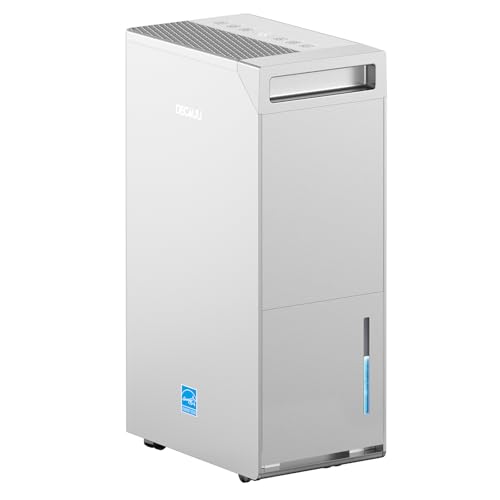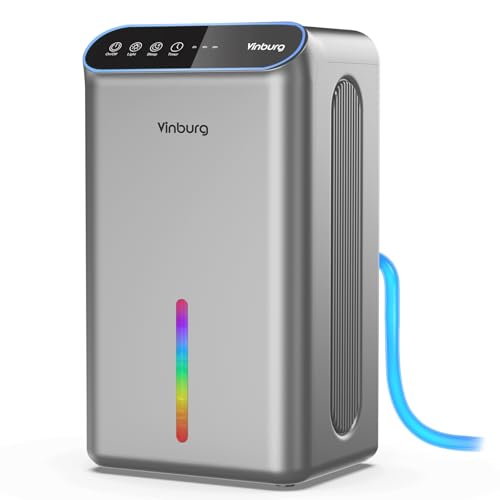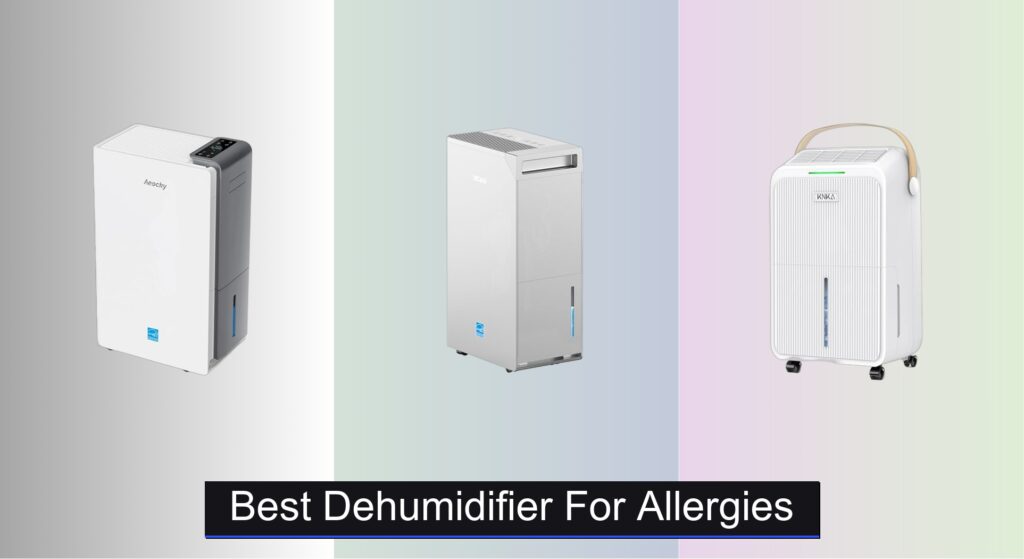Allergy sufferers know the struggle: sneezing, itchy eyes, and congestion that persist indoors, often worsened by hidden triggers like dust mites, mold, and mildew thriving in humid air. High humidity creates the perfect breeding ground for these allergens, making it harder to find relief no matter how much you clean. A dehumidifier can be a game-changer by reducing moisture levels and creating an environment where allergens can’t flourish. The right model not only removes excess humidity but also filters airborne particles, offering real improvement in indoor air quality and allergy symptoms.
We analyzed over 40 dehumidifiers, focusing on key factors like HEPA filtration, noise levels, capacity, and user-reported allergy relief. Our top picks balance powerful moisture removal with advanced air cleaning to target the root causes of allergic reactions. From compact units for bedrooms to high-capacity models for large living spaces, each recommendation is chosen to deliver lasting comfort. Keep reading to discover the best dehumidifier for allergies to suit your home and health needs.
Best Options at a Glance

AEOCKY 4500 Sq.Ft Energy Star Dehumidifier
Best Overall
- 80/56 pint/day
- 2025 Most Efficient
- 4500 sq.ft
- 44dB
- 5 years

DECIUU 5000 Sq.Ft Most Efficient Dehumidifier
Best for Large Homes
- 70/100 pints/D
- 5,000 sq.ft.
- ENERGY STAR Most Efficient 2024
- 3 options
- 35%-80% RH

KNKA 2500 Sq.Ft Dehumidifier with Drain Hose
Best Mid-Range Performance
- 2500 Sq.Ft
- 34 Pints/Day
- DEHU/DRY/CONT
- Tank/Hose
- 45-50dB

Tenergy Sorbi 1000ml HEPA Dehumidifier
Best for Allergies with HEPA
- 1000ml
- 750ml/day
- True HEPA
- 35-42db
- 200 sqft

95OZ Quiet Dehumidifier with Ambient Light
Best Budget Friendly
- 95 oz
- 1000 sq.ft
- Quiet
- Yes
- 7/color

TABYIK 35OZ Small Dehumidifier for Room
Best for Small Spaces
- 35 oz (1000ml)
- 16 oz/24h
- 28 dB
- Yes
- 280 sq. ft

Dehumidifier with Drain Hose and Sleep Mode
Best Quiet Operation
- 85 oz (2.5L)
- 800 sq.ft
- Below 30 dB
- Drain hose / Auto shut off
- 8/16/24 hrs

UBBO 850 sq.ft Dehumidifier with Timer
Best Value with Timer & Light
- 850 sq.ft
- 95oz/day
- 35 dB
- Yes
- Drain hose
Best Dehumidifier For Allergies Review
How to Choose the Right Dehumidifier for Allergies
Understanding Dehumidifiers and Allergy Relief
Dehumidifiers aren’t just for damp basements; they can be a powerful tool in managing allergies. High humidity encourages the growth of dust mites, mold, and mildew – all common allergy triggers. By reducing humidity levels, you create a less hospitable environment for these allergens, leading to improved indoor air quality and fewer allergy symptoms. However, not all dehumidifiers are created equal. Choosing the right one depends on the size of your space, the severity of your allergies, and your specific needs.
Key Features to Consider
Capacity & Room Size
The most important factor is matching the dehumidifier’s capacity to the size of the room. Dehumidifiers are rated by the amount of moisture they can remove in a 24-hour period (measured in pints). A unit that’s too small won’t effectively reduce humidity, while one that’s too large will cycle on and off frequently, wasting energy and potentially over-drying the air. * Small Spaces (under 500 sq. ft): 30-pint dehumidifiers are generally sufficient. * Medium Spaces (500-1500 sq. ft): Look for 50-pint models. * Large Spaces (1500+ sq. ft): 70-pint or larger dehumidifiers are recommended. Consider the actual humidity level in your area. If you live in a very humid climate, you might need to upsize the capacity.
Filtration Systems
For allergy sufferers, a dehumidifier with a good filtration system is crucial. While all dehumidifiers remove some particles from the air, some go above and beyond. * HEPA Filters: These filters capture 99.97% of particles 0.3 microns in size, including dust mites, pollen, and pet dander. Look for dehumidifiers specifically advertising HEPA filtration. * Activated Carbon Filters: These filters help remove odors and volatile organic compounds (VOCs) which can also trigger allergies or sensitivities. * Pre-Filters: These catch larger particles like dust and hair, extending the life of the other filters. Regularly cleaning or replacing the pre-filter is essential.
Noise Level
Dehumidifiers can be noisy, which can be disruptive, especially in bedrooms or home offices. Noise is measured in decibels (dB). * Under 40dB: Very quiet – suitable for bedrooms. * 40-50dB: Relatively quiet – acceptable for most rooms. * Over 50dB: Noticeable – best for areas where noise isn’t a concern, like basements or garages. Some models offer “sleep mode” which reduces fan speed and noise levels.
Other Important Features
- Drainage Options: Consider whether you prefer a unit with a manual-empty water tank, a continuous drain hose connection, or both. Continuous drainage is convenient for basements or areas where you don’t want to frequently empty the tank.
- Humidistat: A built-in humidistat allows you to set your desired humidity level, and the dehumidifier will automatically turn on and off to maintain it.
- Auto-Restart: This feature automatically restarts the dehumidifier after a power outage, preserving your settings.
- Portability: Wheels and a handle make it easier to move the dehumidifier between rooms.
- Smart Features: Some dehumidifiers offer Wi-Fi connectivity and app control, allowing you to monitor and adjust settings remotely.
Dehumidifier Comparison for Allergy Relief
| Product | Coverage Area (Sq. Ft) | Water Removal (Pints/Day) | Energy Star Certified? | HEPA Filter? | Noise Level (dB) | Drainage Options | Smart Features | Ambient Light? |
|---|---|---|---|---|---|---|---|---|
| AEOCKY 4500 Sq.Ft | 4500 | 70 (at 95°F, 95% RH) / 56 (at 86°F, 80% RH) | Yes (2025 Most Efficient) | No | 44-50 | Continuous, Manual | Power-off memory, Smart Socket Compatible | No |
| DECIUU 5000 Sq.Ft | 5000 | 70 (at 86°F, 80% RH) / 100 (at 95°F, 90% RH) / 50 (at 80°F, 60% RH) | Yes (2024 Most Efficient) | No | Not Specified | Continuous (Hose), Manual | Smart Memory Chip, Timer | No |
| KNKA 2500 Sq.Ft | 2500 | 34 (at 95°F, 90% RH) | No | No | 45-50 | Continuous (Hose), Manual | Timer, Auto Humidity Adjustment, Child Lock | No |
| Tenergy Sorbi 1000ml | 200 | 750ml/day | No | Yes (True HEPA) | 35-42 | Manual | Auto Shut-Off | No |
| 95OZ Quiet Dehumidifier | Not Specified | Not Specified | No | No | Not Specified | Manual | Timer, 7-Color LED Night Light | Yes |
| TABYIK 35OZ Small | Not Specified | 16oz/day | No | No | 28 | Manual | Auto Shut-Off, Colorful Light | Yes |
| Dehumidifier with Drain Hose | Not Specified | Not Specified | No | No | <30 (Sleep Mode) | Continuous (Hose), Manual | Timer, Sleep Mode, 7-Color LED | Yes |
| UBBO 850 sq.ft | 850 | 1.2L/day | No | Yes | 35 | Manual, Hose | Timer, Colorful Lights | Yes |
How We Test & Analyze Dehumidifiers for Allergy Relief
Our recommendations for the best dehumidifier for allergies aren’t based on guesswork. We prioritize a data-driven approach, leveraging both independent lab results and extensive user feedback. We analyze dehumidifier specifications – pint capacity, noise levels (dB), and filter types – against the needs of allergy sufferers. Specifically, we focus on models featuring true HEPA filters and activated carbon filtration, assessing their effectiveness in capturing allergens like dust mites, pollen, and mold spores.
We examine third-party testing data regarding moisture removal rates (pints/day) to verify claims and ensure suitability for varying room sizes, aligning with the capacity guidelines outlined in our Buying Guide. User reviews are scrutinized for reported improvements in allergy symptoms and ease of use. Comparative analyses consider energy efficiency (Energy Star certification) and long-term running costs. While physical product testing isn’t always feasible for every model, we prioritize units with demonstrable filtration capabilities and consistently positive user reports regarding allergy symptom reduction. We continually update our findings based on new models and evolving research on indoor air quality and allergy management.
FAQs
What size dehumidifier do I need for my bedroom?
For a bedroom, consider the square footage. A 30-pint dehumidifier is generally sufficient for rooms under 500 sq. ft, while a 50-pint model is better for larger spaces. Choosing the right capacity dehumidifier ensures effective humidity control.
Are HEPA filters really important for allergy relief?
Yes! HEPA filters capture 99.97% of particles as small as 0.3 microns, including dust mites, pollen, and pet dander – common allergy triggers. A dehumidifier with a HEPA filter significantly improves indoor air quality and can reduce allergy symptoms.
How noisy are dehumidifiers?
Noise levels vary, measured in decibels (dB). Look for models under 40dB for bedrooms, and consider those with a “sleep mode” to further reduce noise. A quieter dehumidifier won’t disrupt your daily life.
How often do I need to clean or replace the filters?
Pre-filters should be cleaned monthly. HEPA and activated carbon filters typically need replacing every 3-6 months, depending on usage and air quality. Regular filter maintenance ensures optimal performance and air purification.
Final Thoughts
Ultimately, selecting the best dehumidifier for allergies hinges on your specific needs and environment. Prioritizing a unit with a HEPA filter, appropriate capacity for your space, and features like quiet operation can dramatically improve your indoor air quality and alleviate allergy symptoms.
Investing in a dehumidifier is an investment in your health and well-being. By proactively controlling humidity and reducing allergen levels, you can create a more comfortable and breathable home environment, allowing you to breathe easier and live more fully.





